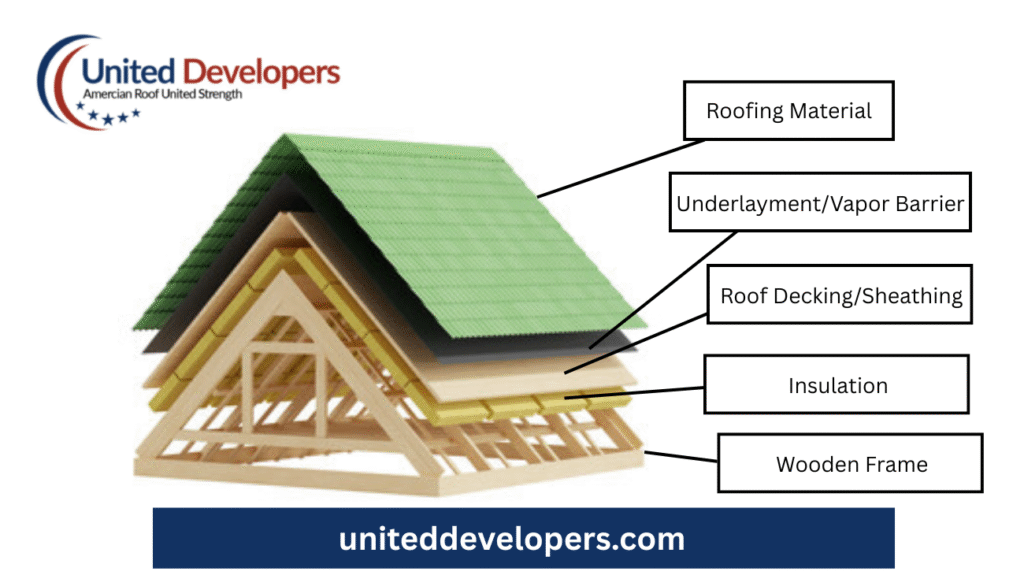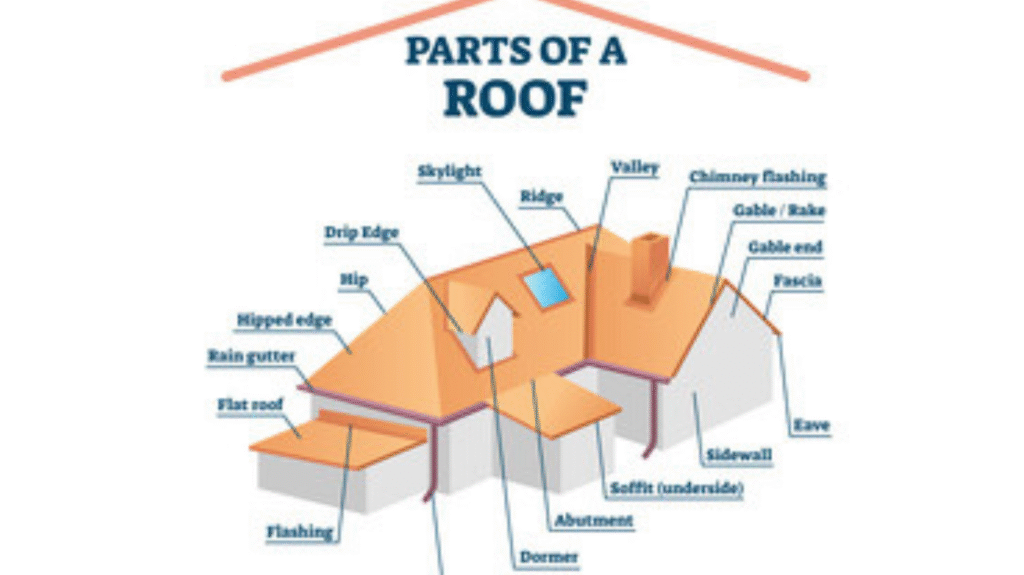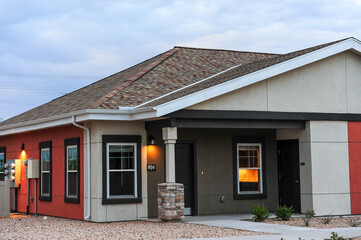A strong, well-built roof is essential for protecting your home from the elements, improving energy efficiency, and maintaining structural integrity. Understanding the parts of a roof and their functions is key to making informed decisions about maintenance, repairs, and new construction. For homeowners and developers in Maryland, knowing how each component works can save money and prevent costly issues down the line.
At United Developers, we specialize in roofing and construction services, helping clients select the right materials and design for long-lasting performance. In this guide, we’ll explore the main parts of a roof, their functions, and why each one matters.
Why Understanding Parts of a Roof Matters
Knowing the key components of your roof helps you:
- Identify potential problems before they become costly repairs
- Make informed decisions when choosing roofing materials
- Understand maintenance requirements
- Ensure the long-term health and safety of your home
Maryland’s weather – hot summers, heavy rains, snow, and occasional storms, places unique demands on roofs. Understanding each component allows homeowners to make proactive choices that protect their investment.

1. Roof Deck (Sheathing)
The roof deck, also called the sheathing, is the foundational layer of a roof. It is typically made from plywood or oriented strand board (OSB) and is installed over the roof trusses or rafters.
Function:
- Provides structural support for the roof
- Serves as the base for all other roofing layers, including underlayment and shingles
- Helps distribute weight evenly across the roof structure
Why It Matters:
A damaged or weak roof deck can compromise the entire roofing system, leading to leaks, sagging, or even structural failure. Regular inspection and maintenance of the roof deck are crucial to ensure the longevity of your roof.
2. Roof Trusses and Rafters
Trusses and rafters form the skeleton of the roof, giving it shape and strength. Trusses are pre-engineered triangular structures, while rafters are individual sloped beams.
Function:
- Support the weight of the roof deck and roofing materials
- Maintain the roof’s shape and pitch
- Provide stability during heavy snow, wind, or storm conditions
Why It Matters:
Strong trusses and rafters prevent sagging and structural damage. Poorly constructed or weakened trusses can lead to uneven roofing, leaks, and increased repair costs.
3. Underlayment
The underlayment is a protective layer installed between the roof deck and the shingles. Common materials include felt paper, synthetic underlayment, or ice and water shields.
Function:
- Acts as a secondary barrier against water infiltration
- Protects the roof deck from moisture, wind-driven rain, and ice dams
- Enhances the roof’s durability and lifespan
Why It Matters:
Even high-quality shingles can fail without proper underlayment. It provides critical protection against leaks and water damage, especially in Maryland’s varied climate, where heavy rains and snow are common.
4. Shingles or Roof Covering
Shingles are the most visible part of the roof and are available in various materials, including asphalt, metal, slate, or tile.
Function:
- Shields the home from rain, snow, UV rays, and wind
- Contributes to energy efficiency by reflecting or absorbing sunlight
- Adds aesthetic appeal and can increase property value
Why It Matters:
Choosing the right shingles for your home is crucial for protection and longevity. High-quality shingles combined with proper installation reduce the risk of leaks, mold, and premature wear.
5. Ridge and Hip
The ridge is the horizontal line where two roof planes meet at the top, while hips are the external angles formed where two roof sections meet.
Function:
- Provide structural stability and define the roof’s shape
- Allow proper water drainage and ventilation when combined with ridge vents
- Support roofing materials at the junction points
Why It Matters:
Improper installation of ridges and hips can cause water intrusion and reduce the roof’s structural integrity. Ridge vents also play a crucial role in maintaining attic ventilation, preventing moisture buildup, and regulating temperature.
6. Roof Flashing
Flashing is typically made from metal and is installed around roof penetrations like chimneys, vents, skylights, and valleys.
Function:
- Directs water away from vulnerable areas
- Prevents leaks around joints and penetrations
- Reinforces roofing materials in critical zones
Why It Matters:
Flashing failure is a common cause of roof leaks. Proper installation and regular inspection of flashing protect your roof from water damage and structural deterioration.
7. Gutters and Downspouts
While technically part of the drainage system, gutters and downspouts are integral to roof function.
Function:
- Collect and channel rainwater away from the roof and foundation
- Prevent soil erosion and basement flooding
- Protect siding and landscaping from water damage
Why It Matters:
Clogged or damaged gutters can cause water to back up, leading to leaks and roof damage. Regular maintenance ensures effective water drainage and prolongs the life of your roofing system.
8. Soffits and Fascia
Soffits are installed under the roof overhang, and fascia boards run along the edge of the roofline.
Function:
- Soffits allow airflow into the attic to prevent moisture buildup
- Fascia provides a finished edge and supports gutters
- Both protect roof edges from wind, water, and pests
Why It Matters:
Properly installed soffits and fascia help maintain attic ventilation, reduce mold growth, and prevent insect infestations. They also enhance the roof’s appearance and structural integrity.
9. Drip Edge
The drip edge is a metal strip installed along roof edges.
Function:
- Directs water away from the fascia and underlying roof components
- Prevents water from seeping under shingles
- Protects the roof deck and foundation
Why It Matters:
Installing a drip edge is essential for preventing water damage and extending the life of your roof. It’s a small component with a significant impact on roof performance.
10. Valleys
Valleys are the internal angles formed where two roof planes meet. They are critical for directing water off the roof.
Function:
- Facilitate water drainage from roof planes
- Protect against leaks at junction points
- Support proper roof flow design
Why It Matters:
Valleys are high-risk areas for leaks. Proper flashing and installation are necessary to ensure that water flows correctly without causing damage.
11. Roof Ventilation Components
Roof ventilation includes ridge vents, soffit vents, and gable vents. Proper ventilation regulates temperature and moisture levels in the attic.
Function:
- Reduces heat buildup in the attic
- Prevents condensation and mold growth
- Prolongs the life of shingles and roof structure
Why It Matters:
Poor ventilation can lead to premature aging of roofing materials, higher energy bills, and moisture-related structural issues. Maryland homes benefit from well-designed ventilation systems to handle hot summers and snowy winters.
12. Chimneys and Roof Penetrations
Chimneys, skylights, plumbing vents, and exhaust vents penetrate the roof surface.
Function:
- Allow ventilation, natural light, and exhaust from fireplaces or HVAC systems
- Require specialized flashing to prevent leaks
Why It Matters:
Every penetration is a potential entry point for water. Correct installation and maintenance are crucial to prevent water damage and maintain roof integrity.
Main Parts of a Roof: Summary
Understanding the main parts of a roof can help homeowners make informed decisions about maintenance, repairs, or replacement. The table below summarizes the key roof components, their function, and importance:
| Roof Part | Function | Why It Matters |
|---|---|---|
| Roof Deck (Sheathing) | Provides structural support for all other roofing layers | Weak or damaged decks can cause leaks and structural issues |
| Trusses & Rafters | Support roof weight and maintain shape | Prevent sagging and structural failure |
| Underlayment | Acts as a secondary water barrier | Protects against leaks and moisture damage |
| Shingles/Roof Covering | Shields home from weather and enhances appearance | Determines roof longevity and energy efficiency |
| Ridge & Hip | Provides structural stability and allows ventilation | Reduces water intrusion and supports roof design |
| Flashing | Directs water away from vulnerable areas | Prevents leaks at roof penetrations |
| Gutters & Downspouts | Channels water away from roof and foundation | Prevents water damage, erosion, and basement flooding |
| Soffits & Fascia | Provides ventilation and protects edges | Prevents mold, insect infestation, and structural damage |
| Drip Edge | Directs water away from fascia and deck | Protects roof edges and foundation |
| Valleys | Direct water from intersecting roof planes | Prevents leaks at junctions |
| Ventilation (vents) | Regulates attic temperature and moisture | Prolongs roof lifespan and reduces energy costs |
| Chimneys & Penetrations | Allow venting, light, and exhaust | Require proper flashing to avoid leaks |
Roof Parts Diagram
Consider adding a labeled diagram to visualize each component. These visuals help homeowners and DIYers better understand roofing structure.

Getting Roofing Quotes and Free Estimates
- Always get multiple roof repair quotes.
- Use services that offer free estimates for roof repair.
- Check reviews before hiring.
Roof Maintenance Tips
To extend the life of your roof and all its components:
- Inspect your roof every 1–2 years, especially after storms
- Clean gutters and downspouts regularly
- Check flashing, valleys, and penetrations for leaks
- Remove debris and keep the roof surface clear
- Maintain attic ventilation and insulation
- Address minor repairs promptly
Proper maintenance protects every part of your roof and saves money in the long run.
Final Thoughts
The parts of a roof work together to provide protection, structural support, and aesthetic appeal. From the roof deck and trusses to shingles, flashing, and ventilation, each component plays a vital role in keeping your home safe and efficient.
For homeowners in Maryland, investing in quality materials and professional installation is essential. United Developers specializes in roofing and siding services, helping you understand every part of your roof and ensuring it performs at its best for years to come. Understanding your roof’s components allows you to make informed decisions, prevent damage, and maintain the beauty and value of your home.


